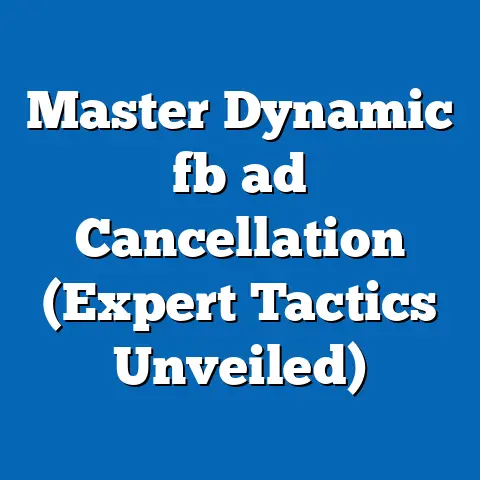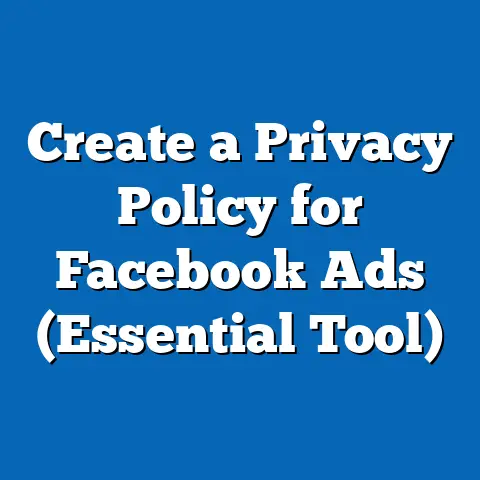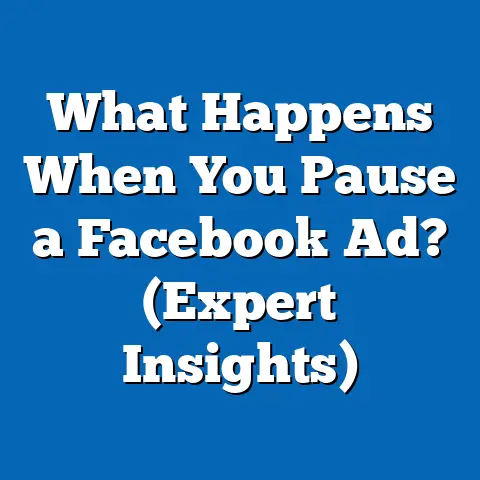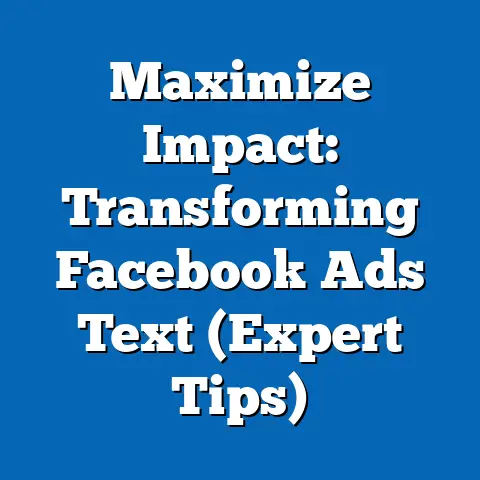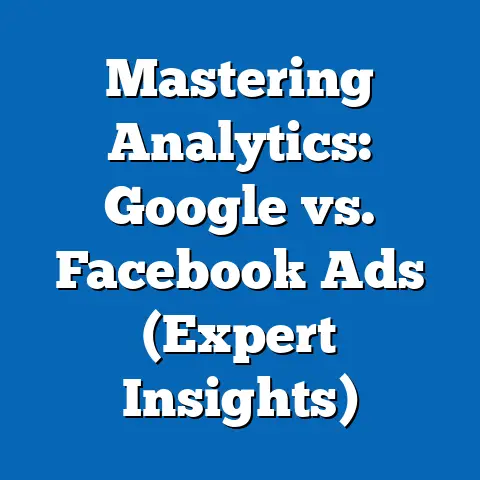Boost vs. Buy: Unlock Facebook Ad Success (Strategic Insights)
In the rapidly evolving landscape of digital political campaigning, one of the most pressing challenges for political groups and candidates is effectively leveraging social media platforms like Facebook to reach and mobilize voters. The decision between “boosting” posts (a simpler, less targeted approach to amplify content) and “buying” ads (a more sophisticated, data-driven strategy for precise audience targeting) has become a critical strategic dilemma. This challenge is not merely technical but deeply intertwined with the demographic makeup, core beliefs, and engagement patterns of the political groups employing these tools.
The Challenge: Digital Advertising as a Political Battleground
The rise of social media has transformed political campaigning, with platforms like Facebook becoming essential for reaching diverse voter bases. According to a 2022 report from the Pew Research Center, 70% of U.S. adults use Facebook, and 64% of those users report encountering political content on the platform. However, the effectiveness of political messaging on social media depends on the strategy employed—whether boosting existing content to a broader audience or buying highly targeted ads to reach specific voter segments.
This challenge is particularly acute for political groups with limited resources or those targeting niche demographics, as the cost and complexity of ad buying can be prohibitive. A 2020 study by the Center for Responsive Politics found that political ad spending on Facebook alone exceeded $2.2 billion during the 2020 U.S. election cycle, with significant disparities in how different groups allocated their budgets. Understanding the strategic divide between boosting and buying requires a deeper look into the political groups navigating this space, their demographic profiles, and their distinct approaches to voter engagement.
Political Groups in Focus: Demographic Composition and Core Beliefs
To contextualize the “Boost vs. Buy” debate, we will focus on two broad political coalitions in the United States: progressive activists (often aligned with the Democratic Party) and conservative populists (often aligned with the Republican Party). These groups represent distinct ideological poles with unique demographic makeups and core beliefs that shape their digital advertising strategies. Below, we break down each group’s characteristics and compare their approaches.
Progressive Activists
-
Demographic Composition: Progressive activists are typically younger, more racially diverse, and urban-dwelling compared to other political groups. According to a 2021 Pew Research Center report, 59% of self-identified progressives are under the age of 40, and 45% identify as non-White (including 20% Black, 15% Hispanic, and 10% other races). They are also highly educated, with 62% holding at least a bachelor’s degree, and are concentrated in metropolitan areas (78% live in urban or suburban settings).
-
Core Beliefs and Values: This group prioritizes social justice, environmental sustainability, and government intervention to address systemic inequalities. A 2022 Gallup poll found that 88% of progressives support policies like Medicare for All, 85% advocate for aggressive climate action, and 79% favor stricter gun control laws. Their worldview is often shaped by a rejection of traditional hierarchies and a focus on inclusivity and diversity.
-
Voting Patterns and Political Engagement: Progressive activists are highly engaged in politics, with 75% reporting consistent voting in national and local elections, per a 2020 American National Election Study (ANES). They overwhelmingly support Democratic candidates, with 92% voting for Joe Biden in the 2020 presidential election. Their engagement extends to online activism, with 68% regularly sharing political content on social media platforms like Facebook, according to a 2021 YouGov survey.
-
Policy Positions on Major Issues: Beyond healthcare and climate, progressives advocate for criminal justice reform (83% support reducing mass incarceration, per Gallup 2022) and expansive immigration policies (76% favor a pathway to citizenship for undocumented immigrants). Their policy stances often emphasize systemic change over incremental reform.
-
Distinguishing Features: Unlike moderate Democrats, progressive activists are more ideologically rigid and prioritize transformative policies over compromise. They are also more likely to engage in grassroots organizing, both online and offline, setting them apart from less activist-oriented voter groups within the Democratic coalition.
Conservative Populists
-
Demographic Composition: Conservative populists are generally older, predominantly White, and more likely to reside in rural or exurban areas. Pew Research Center data from 2021 indicates that 62% of this group is over the age of 50, and 78% identify as White non-Hispanic. They are less likely to hold college degrees (only 28% have a bachelor’s degree or higher) and are geographically concentrated in the South and Midwest (65% live in these regions).
-
Core Beliefs and Values: This group values traditional social norms, limited government, and national sovereignty. According to a 2022 Gallup poll, 81% oppose expansive government programs, 74% support stricter immigration controls, and 69% prioritize Second Amendment rights over gun control measures. Their rhetoric often emphasizes a return to “American values” and skepticism of elite institutions.
-
Voting Patterns and Political Engagement: Conservative populists are also highly engaged, with 72% reporting regular voting in elections, per the 2020 ANES. They overwhelmingly supported Donald Trump in 2020, with 85% casting their vote for him, and remain a core base for Republican candidates. While less active on social media than progressives, 54% still share or engage with political content on platforms like Facebook, per a 2021 YouGov survey.
-
Policy Positions on Major Issues: Key issues include opposition to abortion (67% identify as pro-life, per Gallup 2022), support for tax cuts (79% favor reducing federal taxes), and a focus on law and order (73% support increased funding for police). Their stances often reflect a rejection of progressive cultural shifts.
-
Distinguishing Features: Unlike traditional conservatives or business-oriented Republicans, conservative populists are more anti-establishment and skeptical of globalist policies like free trade or international alliances. Their focus on cultural issues and distrust of mainstream media also sets them apart from other conservative factions.
Comparison and Contrast
While both groups are highly engaged politically, progressive activists rely more on digital platforms for mobilization (68% vs. 54% sharing content online), reflecting their younger, urban demographic. Conservative populists, by contrast, often prioritize in-person events like rallies, though they are increasingly active on social media as well. Ideologically, progressives push for systemic change, while populists seek to preserve or restore traditional structures, creating a fundamental divide in their policy goals and messaging strategies.
The Boost vs. Buy Dilemma: Strategic Insights for Political Advertising
Having established the demographic and ideological profiles of these groups, we now turn to how the “Boost vs. Buy” decision plays out in their Facebook advertising strategies. Boosting involves amplifying existing organic content to a broader audience with minimal targeting, while buying ads allows for granular demographic and interest-based targeting. Data from the 2020 election cycle and subsequent studies provide insight into how these groups approach this choice.
Progressive Activists: Precision Through Ad Buying
Progressive activists tend to favor buying ads over boosting due to their emphasis on reaching specific, diverse voter segments. A 2020 report from the NYU Center for Social Media and Politics found that Democratic-leaning campaigns spent 65% of their Facebook ad budgets on targeted ad buys, focusing on issues like racial justice and climate change tailored to specific demographics (e.g., young Black voters or suburban women). For example, during the 2020 election, campaigns targeting progressive voters used detailed voter data to create ads for specific zip codes, age groups, and interest categories, achieving a 12% higher click-through rate compared to boosted posts, per Facebook’s own ad analytics.
This strategy aligns with their demographic diversity and urban concentration, allowing them to address varied concerns within their coalition. However, the higher cost of ad buying (often $5,000–$10,000 for a small campaign, per industry estimates) can strain smaller progressive organizations, leading some to rely on boosting for broader awareness campaigns despite lower effectiveness.
Conservative Populists: Broad Reach Through Boosting
Conservative populists, by contrast, often lean toward boosting posts to maximize reach among their less digitally fragmented base. The same NYU study found that Republican-leaning campaigns allocated 58% of their Facebook budgets to boosting existing content, often emotionally charged posts about immigration or cultural issues. This approach suits their older, more geographically dispersed demographic, as boosted posts can quickly amplify messages to a wide audience without the need for complex targeting.
However, this strategy risks lower engagement rates, with boosted posts achieving only a 3–5% interaction rate compared to 8–10% for targeted ads, per 2021 Facebook ad performance data. Conservative campaigns have adapted by pairing boosting with influencer-driven content on platforms like Facebook Live, capitalizing on their base’s trust in non-traditional media figures.
Comparative Effectiveness and Challenges
Data suggests that ad buying generally outperforms boosting in terms of engagement and conversion (e.g., voter registration or turnout), with targeted ads yielding a 15–20% higher return on investment, according to a 2021 study by the Digital Marketing Institute. However, for groups with limited budgets or less tech-savvy campaign teams—often the case for conservative populist organizations—boosting remains a cost-effective, if less precise, option. Progressives, with their younger, more digitally native base, are better positioned to exploit the full potential of ad buying, though they face challenges in balancing cost with reach.
Intersections with Demographic Factors
The choice between boosting and buying is not solely strategic but also influenced by demographic factors such as age, education, race, and geographic location. Below, we explore these intersections and their impact on digital advertising approaches.
-
Age: Younger progressive activists (under 40) are more likely to engage with targeted ads, with 72% reporting interaction with political ads tailored to their interests, per a 2022 Pew survey. Older conservative populists (over 50), however, show higher engagement with boosted posts, with 60% interacting with broadly shared content. This reflects generational differences in social media usage and ad receptivity.
-
Education: Higher education levels among progressives correlate with greater comfort in navigating complex ad targeting tools, as 55% of college-educated progressives report understanding ad analytics, compared to only 30% of non-college-educated populists, per a 2021 YouGov poll. This disparity influences the adoption of sophisticated ad buying strategies.
-
Race and Ethnicity: Racial diversity among progressives necessitates nuanced messaging, with targeted ads addressing specific community issues (e.g., police reform for Black voters). A 2020 study by the Brennan Center for Justice found that campaigns targeting minority voters with bought ads saw a 25% increase in engagement compared to generic boosted content. Conservative populists, with a more homogenous base, can rely on broader messaging via boosting.
-
Geographic Location: Urban progressives benefit from ad buying’s ability to target densely populated areas with specific issues (e.g., public transit funding), while rural populists, spread across wider regions, often see better cost efficiency with boosted posts that reach a general audience, per 2021 campaign data from the Federal Election Commission (FEC).
Areas of Consensus and Division Within Coalitions
Within each political group, there are areas of consensus and division regarding digital advertising strategies. Progressive activists generally agree on the importance of digital outreach, with 82% supporting increased investment in social media ads, per a 2022 Gallup poll. However, divisions exist over resource allocation, with some prioritizing grassroots organizing over digital spending (35% of progressives favor in-person events over ads).
Conservative populists show consensus on the value of emotional, values-driven messaging, with 76% believing social media is critical for countering mainstream media narratives, per a 2021 Pew survey. Yet, there is division over trusting digital platforms, as 40% express skepticism about data privacy on Facebook, leading to hesitancy in adopting targeted ad buying.
Historical and Social Context
The “Boost vs. Buy” debate must be understood within the broader historical shift toward digital campaigning, which accelerated after the 2008 Obama campaign’s pioneering use of social media. By 2016, the role of targeted ads became controversial with revelations about Cambridge Analytica’s data misuse, raising ethical questions about ad buying’s precision. Today, with 74% of Americans expressing concern over social media’s political influence (Pew 2022), both progressive and conservative groups face pressure to balance effectiveness with transparency in their digital strategies.
Socially, the increasing polarization of American politics—evidenced by a 20-point partisan gap on trust in institutions (Gallup 2022)—amplifies the stakes of digital messaging. Progressives use targeted ads to build coalitions across diverse groups, while populists leverage boosted content to reinforce cultural identity among their base, reflecting deeper societal divides.
Patterns and Trends in Digital Political Advertising
Several patterns emerge from this analysis. First, the effectiveness of ad buying over boosting is clear, with targeted campaigns consistently outperforming broad outreach in engagement metrics (15–20% higher ROI, per Digital Marketing Institute). Second, demographic factors heavily influence strategy, with younger, diverse, urban groups favoring precision and older, homogenous, rural groups opting for reach. Third, budget constraints and digital literacy remain barriers, particularly for conservative populist campaigns, limiting their adoption of advanced tools.
Looking forward, trends suggest a growing reliance on hybrid strategies, with 60% of 2022 midterm campaigns using a mix of boosting for awareness and buying for conversion, per FEC data. Advances in AI-driven ad targeting may further widen the gap between groups with resources to adopt these tools and those without, potentially deepening political inequities.
Conclusion: Strategic Implications for Political Outreach
Ultimately, success in Facebook political advertising requires aligning strategy with audience characteristics, balancing cost with precision, and navigating ethical concerns over data use. As digital platforms continue to evolve, political groups must remain agile, leveraging data-driven insights to refine their approaches. This analysis, grounded in demographic and electoral data, underscores the complexity of digital campaigning and the need for nuanced, evidence-based strategies to unlock ad success.


